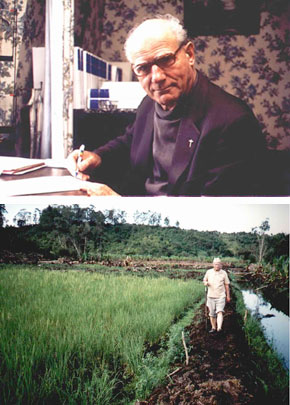ORIGIN OF THE SYSTEM OF RICE INTENSIFICATION (SRI)

The SRI methodology was synthesized in the early 1980s by Fr. Henri de Laulanié, S.J., who came to Madagascar from France in 1961 and spent the next (and last) 34 years of his life working with Malagasy farmers to improve their agricultural systems, and particularly their rice production, since rice is the staple food in Madagascar (see article listed below). Rice provides more than half the daily calories consumed in Madagascar, a sign of the cultural and historic significance of rice to Malagasies, but also an indication of their poverty. Fr. Laulanié want to help farmers improve their productivity without being dependent on external inputs because Malagasy households had so little purchasing power.
Fr. de Laulanié (right) established an agricultural school in Antsirabe in 1981 to help rural youths gain an education that was relevant to their vocations and family needs. Though SRI was "discovered" in 1983, benefiting from some serendipity, it took some years to gain confidence that these methods could consistently raise production so substantially. In 1990, together with a number of Malagasy colleagues, Fr. Laulanié established an indigenous non-governmental organization (NGO), named Association Tefy Saina, to work with farmers, other NGOs, and agricultural professionals to improve rural production and livelihoods in Madagascar. (See Uphoff article on Laulanié's innovation).
In 1994, Tefy Saina began working with the Cornell International Institute for Food, Agriculture and Development (CIIFAD) based in Ithaca, NY, to help farmers living in the peripheral zone around Ranomafana National Park to find alternatives to their slash-and-burn agriculture. So long as paddy yields, even with irrigation, averaged only 2 tons/hectare, rural households would need to continue growing upland rice and reducing Madagascar's precious but endangered rain forest ecosystems. These could not last long unless paddy yields were raised on the limited irrigated lowland area. Farmers using SRI methods could averaged 8 tons/hectare after these methods were introduced around Ranomafana. A French project for improving small-scale irrigation systems on the high plateau during this same time period also found that farmers using SRI methods averaged over 8 tons/hectare, compared to 2.5 tons/ha with traditional methods and 3.7 tons/ha with improved methods using fertilizer. A separate evaluation commissioned by the French aid agency (Bilger, 1997) also confirmed average SRI yields of 9 tons/ha.
The name "Tefy Saina" means, in Malagasy, "to improve the mind," indicating that this organization was not concerned just with rice, but also with helping people to change and enrich their thinking. Before he died in June, 1995, Fr. de published one article on SRI in the Belgian journal Tropicultura (13:1, 1993). (See English translation of a longer technical paper by Laulanié). During 2011, to recognize the 30th anniversity of Laulanié's work with SRI, the Tropicultura editors included an article (Intensive rice farming in Madagascar, Tropicultura 29(3):183-187) in their journal, which is based on the original 1993 article.
Since 1997, a number of other papers or articles have been written about SRI. While most interest came initially from NGO and university circles, evaluations are now coming also from national research programs and international research institutes. More information (in French) about Fr. de Laulanié is available on the Tefy Saina website (Henri de Laulanié, le Visionnaire Realiste) and from an obituary in Jesuites en Mission - Chine Madure Madagascar (No. 255, Dec 1995-Jan1996).

